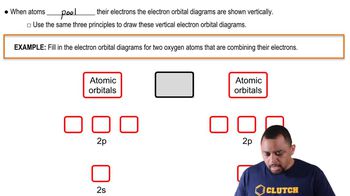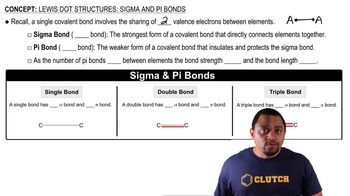Consider the H2+ ion. (f) Which of the following statements about part (e) is correct: (i) The light excites an electron from a bonding orbital to an antibonding orbital, (ii) The light excites an electron from an antibonding orbital to a bonding orbital, or (iii) In the excited state there are more bonding electrons than antibonding electrons?
Ch.9 - Molecular Geometry and Bonding Theories

Brown14th EditionChemistry: The Central ScienceISBN: 9780134414232Not the one you use?Change textbook
Chapter 9, Problem 73a
Draw a picture that shows all three 2p orbitals on one atom and all three 2p orbitals on another atom. (a) Imagine the atoms coming close together to bond. How many σ bonds can the two sets of 2p orbitals make with each other?
 Verified step by step guidance
Verified step by step guidance1
Visualize the 2p orbitals: Each atom has three 2p orbitals, which are oriented along the x, y, and z axes. These orbitals are dumbbell-shaped and are orthogonal to each other.
Draw the 2p orbitals for the first atom: Represent the 2p_x, 2p_y, and 2p_z orbitals. Each orbital should be shown as a pair of lobes extending in opposite directions along their respective axes.
Draw the 2p orbitals for the second atom: Similarly, represent the 2p_x, 2p_y, and 2p_z orbitals for the second atom, ensuring they are oriented along the same axes as the first atom.
Consider the overlap of orbitals: For a σ bond to form, the orbitals must overlap end-to-end. This typically occurs when two orbitals are aligned along the same axis, such as 2p_z of one atom overlapping with 2p_z of the other atom.
Determine the number of σ bonds: Since only one pair of 2p orbitals can overlap end-to-end along the same axis, only one σ bond can form between the two sets of 2p orbitals.

Verified video answer for a similar problem:
This video solution was recommended by our tutors as helpful for the problem above.
Video duration:
3mWas this helpful?
Key Concepts
Here are the essential concepts you must grasp in order to answer the question correctly.
Atomic Orbitals
Atomic orbitals are regions in an atom where there is a high probability of finding electrons. The 2p orbitals are a set of three degenerate orbitals (2p_x, 2p_y, 2p_z) that have specific shapes and orientations in space, allowing them to participate in bonding interactions with other orbitals.
Recommended video:
Guided course

Atomic Orbitals Example
Sigma (σ) Bonds
Sigma bonds are a type of covalent bond formed by the head-on overlap of atomic orbitals. In the case of p orbitals, a σ bond can be formed when two 2p orbitals align along the axis connecting the two nuclei, allowing for effective overlap and electron sharing between the atoms.
Recommended video:
Guided course

Lewis Dot Structures: Sigma & Pi Bonds
Orbital Overlap
Orbital overlap is a fundamental concept in chemical bonding that describes how atomic orbitals from different atoms interact when they come close together. The extent of overlap determines the strength and type of bond formed; for example, effective overlap of 2p orbitals can lead to the formation of σ bonds, while less effective overlap may lead to π bonds.
Recommended video:
Guided course

Molecular Orbital Theory
Related Practice
Textbook Question
Textbook Question
(c) Calculate the bond order in H2-.
Textbook Question
Draw a picture that shows all three 2p orbitals on one atom and all three 2p orbitals on another atom. (b) How many p bonds can the two sets of 2p orbitals make with each other?
Textbook Question
Draw a picture that shows all three 2p orbitals on one atom and all three 2p orbitals on another atom. (c) How many antibonding orbitals, and of what type can be made from the two sets of 2p orbitals?
Textbook Question
Indicate whether each statement is true or false. (a) p orbitals can only make σ or σ* molecular orbitals.
